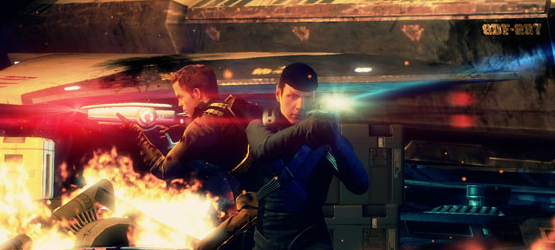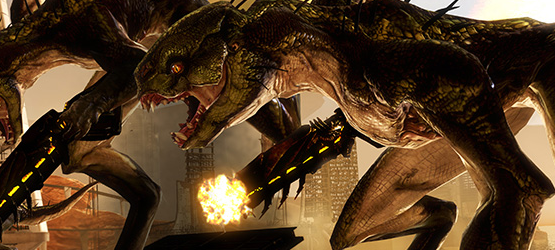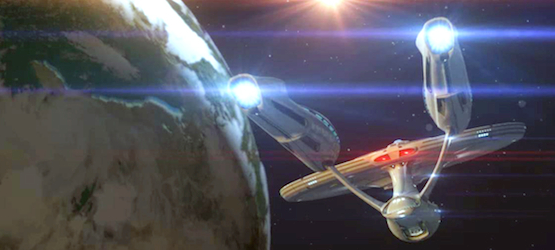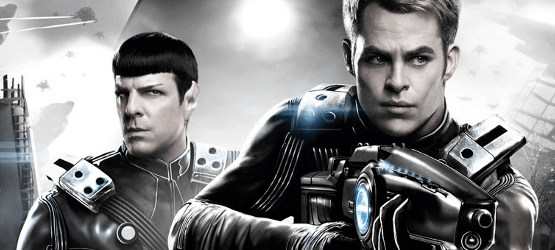The universe in Paramount and Namco-Bandai’s Star Trek: The Video Game is based on the 2009 alternate universe movie. The game actually makes direct references to the movie and serves as an intermediary between Star Trek and the new film Into Darkness. That brings up the most interesting point about this game—it actually attempts to emulate the action and characterization found in the 2009 movie. The banter between Kirk and Spock is pretty good. There are some decent escape sequences. Almost all of the bonus mission objectives involve indirect confrontation or a non-lethal approach to the current situation. Indeed, for a co-op cover-based third person shooter there are plenty of stealth options and stun-based attacks available. Star Trek also attempts to incorporate many diverse gameplay elements in order to maintain the feel of the previous movie in gameplay form. And with that paragraph you have just read almost all the best things about Star Trek: The Video Game.
The plot is an excuse for Kirk to run around and beat things up. Spock comes with him because Vulcans are involved and he would be good as a mediator to Kirk’s rash behavior. Eventually there’s a plot device to recover and a science princess to save, but the game really exists because Bros, yo. If the science princess line has you wondering, both Kirk and Spock save their intended female romantic interests over the course of the game. The narrative interplay between Kirk and Spock does work well. This is great because, as individuals, Kirk is kind of creepy in a sexual harassment way and Spock requires another character to be the straight man. Really—there’s a scene where Kirk puts his hands on T’Mar, the Vulcan science officer responsible for the plot device, in a way that is supposed to show both empathy and Kirk’s groin-interest. The look on her face is not a welcoming one. This could be the graphics, but the graphics are not bad and service the game quite well.

In fact, aside from some texture problems on the enemies in the game, the graphics are what can be expected of a budget title and the music is quite good. There’s nothing to stick in the player’s mind after the game is shut off, but the music is akin to the film and enhances the game in a correct manner. Almost all the vocal work was done by the movie’s actors and most of it comes off as really good. Bones is an exception.
Star Trek’s gameplay is a mixed bag of broken glass and the occasional piece of candy. There are a lot of decent elements to highlight the Star Trek universe – the tri-corder is fairly handy and is used to locate enemy positions, remotely hack into consoles, and extract background codex data for additional experience points. Commendations; gameplay mechanics meant to emulate how a Starfleet officer would handle the current situations and focus on sneaking past enemies or not killing enemies, also earn experience points. These points are then spent on upgrades for the tri-corder or Kirk and Spock’s personal phazers. The game switches up the cover-based mechanic with hacking minigames and adventure sequences, some of which are well done. And those are the pieces of candy.

The broken glass a player must sift through to reach the candies is tremendous. Star Trek is not just about Kirk and Spock’s fight against the malevolent lizard-like Gorn, it’s also their fight against the controllers. The controllers are not a race in the game, but rather the very item players hold in their hands. Simple mechanics such as running and jumping only seem to work when the game permits it. Sliding into cover can be a crapshoot. Extracting a character from cover often causes the character to turn in circles before leaving cover. One hacking minigame requires the analog stick to move a beam along a grid. Simple directional inputs should suffice but the game occasionally fails on even those. Then there are the glitches: Stealth takedowns of Gorn don’t take down the Gorn, but instead freeze the enemy in place. This once happened in a doorway blocking the only path in the level, and a reset had to be done. Reaching checkpoints to continue the story does not always work and often the solution is to run in and out of the room multiple times until the event triggers. I once was caught behind a NPC and had to restart.
In combat, the cover function is almost useless. Enemies can target players regardless, so long as a tiny amount of character is available. Additionally, most enemies in the game have access to flying drones. Guess what else makes cover useless? An enemy whose physical capabilities bring the third dimension into a two-dimensional fight. Enemies can throw these drones out as an ability.

The co-op single player AI is where the game truly reaches abysmal depths. As stated above, there are Commendations giving players the option to not be shot at regardless of cover. Kirk and Spock can sneak up on enemies to stun or enact stealth takedowns. If the bonus commendation requires players to not kill Federation forces, then the AI will accomplish this fantastically. Once the game requires stealth, then the AI automatically interprets any combative action as an excuse to fight. That’s right – the moment a stealth takedown is initiated, the player’s AI partner will start a war with surrounding enemies. After all, you hit someone. So much for the game describing Spock as “tactical, precise, and logical” when he’s wading knee deep in Gorn laser fire. Until then the AI is a great asset to have, since the AI can walk in front of enemies and not be seen. Players cannot leave the AI behind with the obligatory “go there!” command. Wander a little ways off and they follow along. The AI is actually really good to have in combat since it’s a better fighter than the player, until suddenly it’s not. One time, Spock’s AI decided to just stop playing the game and a reset was necessary. In retrospect, this might have been the game trying to give advice to its players.
Levels vary in length and are rather well done, but the longer levels get tedious very quickly. There are plenty of non-cover-based action sequences, such as a space battle using the USS Enterprise, swimming through caverns, or flying through a random environment. Most of these sequences are made of frustration; except the flying sequences. Those were a nice breather. I’d also like to point out in a universe with mass teleportation there’s a lot of excuses to keep characters on a set path.

Online play is available. Matches can be set up at literally any checkpoint in the game, and the quick match function gave quick results. Unfortunately, any players must wait until their intended co-op partner reaches a checkpoint, negating a drop-in/drop-out function this game would benefit from. There’s no indication of what portion of the level the other player is at either, making this function a waiting game. Players can use the find a match function to sidestep some of these problems. Online matches bring their own glitches, though most of these are only graphical and do not impact gameplay.
Trophies are pretty standard for the genre, and players could reach platinum in two playthroughs as long as a friend is handy, and nothing breaks. With two characters to choose from replay value is immediately visible, and the game does let players keep accumulated experience and upgrades between playthroughs. Additionally, players may reset upgrades and experience upon a new game.
Any further berating of the game would just be beating the proverbial dead horse. There are good qualities about this game – nods to other titles which also share strong science fiction or adventure settings—but the overwhelming gameplay issues, bugs which can shut down gameplay, lack of a decent plot, and the overall tedium of the game make it a less than mediocre title. There is promise here, but promises are not proof. Star Trek fans might be interested in this title when it hits the bargain bins. Everyone else will be better off choosing another title to support.
-
Decent co-existence with existing Star Trek media
-
Good interaction between Kirk and Spock
-
Mixes several gameplay types together
-
Mixes several gameplay types together terribly
-
Controls are bad
-
Cover mechanics are bad
-
AI is awful
-
Glitches can prevent gameplay
-
Plot suffers greatly








